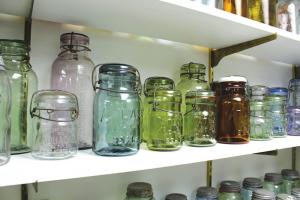Canning Jars Valued By Collectors
 ✖  |
“The thing that’s attractive about them is that they can be found in so many places and they’re reasonable in cost,” says Douglas Leybourne Jr., about collecting old canning jars. His jar journey began about 40 years ago when he paid $1.50 for a box of old, dirty jars at a farm auction.
There wasn’t anything valuable in the box, but since then he’s found many jars that fall into the $100 to $1,000 value range. He knows of 100 or so worth $10,000 and just three or four valued over $30,000.
Through years of collecting, his passion and knowledge led him to author the Red Book - a guide to canning jars.
The jars with thread molds at the top for screw-on lids that are common today are generically called mason jars, based on “Mason’s Patent Nov. 30th, 1858” that is embossed on jars made between 1858 and 1920. After the patent expired, more than 500 companies made their own version of the glass-blown jars.
Original zinc and clamp closures in good condition are difficult to find, and add to the value of a jar, Leybourne says. The challenge is to know the difference between old jars and fake versions made in China and India.
“There’s a part of the book that shows reproductions and also the clamps, closures, and lids, so people know which ones are real,” he says. “If the price looks too good to be true, it is. There’s no wear on the fakes. A 160-year-old jar is going to have wear and not be perfect. They were hand-blown into a mold, so they have bubbles, chewing tobacco, and other bits in the glass. And that’s what makes them wonderful.”
Just as there are many fakes out there, antique and vintage jars are plentiful, found in barns, basements, attics, and yard sales. Leybourne cites the case of an Indiana woman who bought an old jar at a yard sale. It turned out to be a Black Olive jar that sold for $10,000 because only 25 are known to exist.
He loves the wide variety of colors and styles, and though jars can be found online, he prefers to physically see and touch the jars and negotiate prices with sellers at shops and shows. Many shows have resumed and can be found at www.fohbc.org (The Federation of Historical Bottle Collectors).
“The trend is up for values,” he says. “They are a functional antique to display or store stuff in them. The thing I value most is the friends I’ve made through this hobby.”
Contact: FARM SHOW Followup, Douglas M. Leybourne, Jr., P.O. Box 5417, North Muskegon, Mich. 49445 (www.redbookjars.com).

Click here to download page story appeared in.
Click here to read entire issue
Canning Jars Valued By Collectors TRACTORS Modifications “The thing that’s attractive about them is that they can be found in so many places and they’re reasonable in cost ” says Douglas Leybourne Jr about collecting old canning jars His jar journey began about 40 years ago when he paid $1 50 for a box of old dirty jars at a farm auction There wasn’t anything valuable in the box but since then he’s found many jars that fall into the $100 to $1 000 value range He knows of 100 or so worth $10 000 and just three or four valued over $30 000 Through years of collecting his passion and knowledge led him to author the Red Book - a guide to canning jars The jars with thread molds at the top for screw-on lids that are common today are generically called mason jars based on “Mason’s Patent Nov 30th 1858” that is embossed on jars made between 1858 and 1920 After the patent expired more than 500 companies made their own version of the glass-blown jars Original zinc and clamp closures in good condition are difficult to find and add to the value of a jar Leybourne says The challenge is to know the difference between old jars and fake versions made in China and India “There’s a part of the book that shows reproductions and also the clamps closures and lids so people know which ones are real ” he says “If the price looks too good to be true it is There’s no wear on the fakes A 160-year-old jar is going to have wear and not be perfect They were hand-blown into a mold so they have bubbles chewing tobacco and other bits in the glass And that’s what makes them wonderful ” Just as there are many fakes out there antique and vintage jars are plentiful found in barns basements attics and yard sales Leybourne cites the case of an Indiana woman who bought an old jar at a yard sale It turned out to be a Black Olive jar that sold for $10 000 because only 25 are known to exist He loves the wide variety of colors and styles and though jars can be found online he prefers to physically see and touch the jars and negotiate prices with sellers at shops and shows Many shows have resumed and can be found at www fohbc org The Federation of Historical Bottle Collectors “The trend is up for values ” he says “They are a functional antique to display or store stuff in them The thing I value most is the friends I’ve made through this hobby ” Contact: FARM SHOW Followup Douglas M Leybourne Jr P O Box 5417 North Muskegon Mich 49445
To read the rest of this story, download this issue below or click
here to register with your account number.







